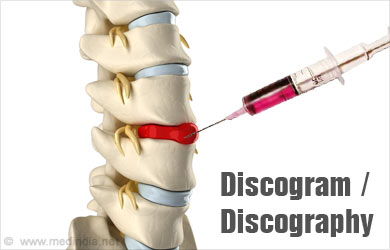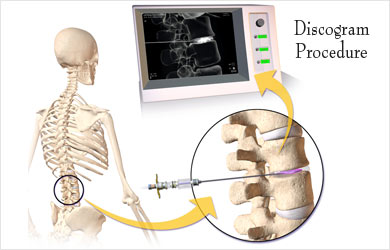- Diagnostic Testing for Degenerative Disc Disease - (http://dx.doi.org/10.1155/2012/413913)
What is Discogram?
Discogram is a radiological procedure used in the diagnosis of back pain related to the intervertebral discs. It helps in locating the disc that generates the pain. In this procedure, a dye is injected into the central part of the disc to study changes in the disc, and detect any pain arising from disc disease.
Back problems, especially chronic low back problems, are a common reason for a visit to a back specialist or an orthopedic surgeon. They can be due to a variety of conditions like muscle spasms, arthritis etc. Degenerative changes in the intervertebral disc, the cushion between the vertebrae, is commonly associated with back pain. Each intervertebral disc has a soft central part called the nucleus pulposus and a surrounding fibrous ring called the annulus fibrosus. Degeneration of the annulus fibrosus can cause the nucleus pulposus to protrude out, resulting in a bulging or herniated disc. The protruded material can press on a nerve resulting in pain.

Back pain is usually diagnosed using imaging techniques like MRI. An MRI can show degenerative changes in the discs. However, some people with back pain may suffer from degenerative changes at multiple levels, but the pain may be due to changes only at a particular level. Also, a disc that appears to be badly affected on MRI may not be causing as much pain as a disc that is mildly affected. These patients are likely to benefit from a discogram prior to surgery to pinpoint the exact disc that causes the pain, so that surgery can be carried out at this level.
Who Requires Discogram?
Discogram is an invasive procedure, and therefore, should not be done in every patient with back pain. However, there are certain patients who could benefit from the procedure:
- Patients with back pain who do not respond to treatment by conservative methods for at least three to four months and require spine surgery. The discogram helps to confirm that the particular disc is the cause of the pain.
- When tests like MRI and CT scan cannot diagnose the cause of back pain, or suggest that multiple discs are affected. Discogram can be used to locate the disc causing the pain in these patients so that they will benefit from a surgery done at this particular level.
- Prior to surgical procedures like spinal fusion, or other procedures like intradiscal electrothermal therapy and chemonucleolysis
Who Should Not Undergo Discogram?
Discogram should not be done in the following situations:
- Infection at the proposed site of injection
- Allergy to the dye. Omnipaque is the dye used for the procedure. Gadolinium may be used in those allergic to omnipaque.
- Bleeding problems or intake of medications that may cause bleeding. Medications like anticoagulants and antiplatelet drugs should be stopped around a week before the procedure
- Spinal problems like fusion of the vertebrae, prior surgery or problems of the spinal cord at the particular level that could worsen with the procedure
- Pregnancy

What Preparation is Required Before a Discogram Procedure?
The patient is instructed not to take pain medications on the day of the procedure so that they can report any pain correctly. The patient should not take food for six to eight hours before the procedure or as directed by the medical team. Blood pressure and oxygen levels should be monitored during the procedure.
How is the Discogram Procedure Carried Out?
The discogram procedure is done under the guidance of fluoroscopy. Fluoroscopy is like a continuous x-ray, which records moving objects. The discogram procedure can be carried out at multiple levels. Once a particular level is identified, a local anesthetic is injected. A special needle is used, which is introduced from the lateral or posterolateral aspect. Once the needle reaches the central part of the disc, the dye is injected. The patient is asked to report if any pain is experienced and if the pain is similar to that the patient usually suffers from.
Injection of the dye into the other diseased discs is carried out in the same procedure. Injection into a normal adjacent disc is also carried out for comparison so that any bias due to the procedure can be ruled out. For example, the patient may be excessively sensitive to the procedure. Thus, if the pain is produced at both the normal as well as the diseased level, it is possible that the diseased disc is not causing the pain.
Following the procedure, the needle is withdrawn and a local bandage is applied. A CT scan, x-ray are also taken to study the dye in the disc. The patient is monitored for around 2 hours following the procedure.

How is a Discogram Interpreted?
The following are assessed during a discogram procedure:
- Whether pain occurs when the disc is injected with the dye. The pain should be similar to the pain that usually troubles the person. At the same time, pain should not be present from the adjacent normal disc
- The amount of dye injected. A degenerated disc usually takes up more dye as compared to a normal disc
- Structural changes of the disc, which can be demonstrated using CT scan following the procedure. The height of the disc is noted. The injected dye should remain within the central part of the disc. Protrusion outside this part may indicate degenerative changes.
What are the Complications due to Discogram?
Like any other invasive procedure, discogram is also associated with complications, which may include the following:
- Discitis, which is inflammation of the intervertebral disc. It may result due to an infection caused by the procedure. It can be prevented by giving antibiotics prior to the procedure
- Trauma resulting in a clot formation, which may press on the spinal cord
- Damage to muscles of the back
- Trauma to the spinal cord resulting in paralysis
- Damage to a nerve
- Headache following the procedure








